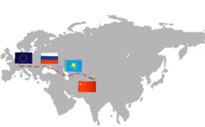By the end of 2016 international corridor will be ready two-thirds – only Russian highway section should be completed
In Kazakhstan highway section of Western Europe-Western China (WE-WC) will be put into operation in 2016. Today, on May 25, this has been reported during the forum “The Great Silk Way countries: energy, resource and stable development” by Timur Zhaksylykov, the Vice-Minister of national economy. The meeting has been arranged within the framework of the IX Astana economy forum that has started today.
Concerning the development of transport infrastructure, Zhaksylykov highlighted the construction of Western Europe-Western China highway corridor, which is considered as “the shortest highway route from China to Europe and it has a huge importance in increasing a transit potential of the whole Eurasian continent”.
“According to calculation, the delivery time of commodity will be 10 days on average. For comparison: sea route is 45 days, transit is 14 days. In Kazakhstan this highway section will be put into operation this year”, reported the Vice-Minister.
Zhaksylykov also added that according to experts’ forecast, by 2020 about 8% of annual commodity circulation, approximately 50 billion USD (3,3 trillion rubles), will go through this transit.
It should be also added that, according to Kazakhstan portals, concerning the highway construction, for today there opened traffic from Russian borders to Almaty oblast through Aktobe, Kyzylorda, Shymkent, Taraz on a section with the length of 2028 km. It was reported in the portal that a full completion of Kazakhstan part of international corridor is planned in 2016.
In total, overall length of the corridor from Russian Saint-Petersburg to Chinese urban district Lyanjungan which is situated on the coast of Yellow sea is 8445 km. 2233 km of them go through the Russian Federation territory, 2787 km through the Republic of Kazakhstan, 3425 km through the People’s Republic of China. The corridor also provides an exit to Uzbekistan and Kyrgyzstan.
The Agreement of Western Europe-Western China corridor construction was concluded in Beijing on April 16, 2009. Within the framework of the document the Chinese party has fully completed the project in their territory up to date.
The correspondent memorandum within the framework of the corridor development was signed in 2008 between transport ministries of Kazakhstan and Russia. The Russian route of the corridor was determined as follows: «Saint-Petesburg-Moscow-Vladimir-Kazan-Bavly-Orenburg-Kazakhstan border».
The portal makes reference to «information of Russian party», according to which since 2012 reconstruction and repair works has been carried out on the following sections: Saint-Petersburg-Moscow, including CRR with the length of 724 km to be completed by 2018, also at particular sections between Moscow and Kazan and Shaly-Bavly.
It should be added that according to Vladislav Inozemptsev, Economy High school professor and Director of “Centre of postindustrial society research”, the project implementation of the Russian part has defects that leads to development of alternative transit ways.
“There occurred a problem from the very beginning: if Kazakhstan almost completed the laying of its highway section at length 2.4 thousand km (I say nothing of Chinese), meanwhile in Beijing Russian partners kept showing only mockups of future roads within the whole year. Now, according to optimistic calculations, CRR will be constructed by 2020, and the road from Kazakhstan border to Central Russia will be, apparently, «renovated» (that is, in essence, it remains in its present condition, non-serviceable for large-scale international transit). In such conditions an attempt to construct “the Silk road” where it always got by-through Central Asia, the Caucasus (probably Iran)” has a big chance for success”, said Inozemptsev.
Meanwhile, the direction, marked by experts, bypassing Russia, develops too. Particularly, in Kazakhstan “one of the important transport corridors of Eurasia” in addition to “WE-WC” is Transcaspian international transport route (TITR), which goes from China through Kazakhstan, Caspian Sea, Azerbaijan, Georgia, Turkey and further to Europe.
In May at the Joint steering committee meeting on TITR development it was offered to coordinate the process from Astana.



















